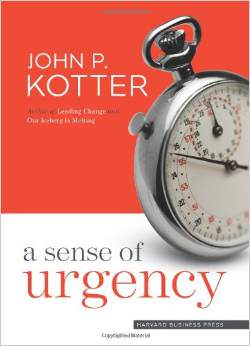Achieve Light Speed Agility in Your Startup
In today’s startup environment, you need to work quickly or you will not succeed. A sense of urgency provides the impetus that allows people and businesses to act swiftly. Speed is a critical component because customers will not wait on you but will turn to competitors who can provide products or services more efficiently.
John P. Kotter in his book, “A Sense of Urgency,” delves into how entrepreneurs can take that first step toward urgency, avoiding pitfalls along the way. He is convinced that increasing the sense of urgency is the toughest of the steps necessary for effective change.
Urgency is not the frantic activity born of excess energy, anger, or frustration, actions that translate into high activity levels but often result in efforts that will be slow in coming and misdirected. Rather, those with a true sense of urgency, according to Kotter, will display the following:
- Behave with urgency every day. Always demonstrate your own sense of urgency in meetings, interactions, memos, and e-mails in a way that is as visible as possible to the maximum number of people. You are the role model for everyone in your organization. If your tone and actions demonstrate apathy, it will percolate quickly to everyone and will become self-perpetuating.
- Consistently communicate urgency. Urgency is a set of thoughts and feelings, as well as a compulsive determination to move and succeed now. Aim for the heart, not just the mind. Look for the element of every story that will compel employees into action. Make employees feel empowered, not stressed, to believe in the need for urgency.
- Create action that is relentlessly aimed at success. Make sure your actions exhibit alertness and demonstrate a focus on success. Show some progress each and every day while constantly eliminating activities that do not contribute to this goal. Be quick to reward the productive actions of everyone on the team.
- Bring the outside in. Be on the lookout for compelling data, people, video, websites, and other important messages from outside the company. Strive to connect internal activity with external happenings and challenges. Highlight competitor contributions in the marketplace in order to continually challenge your own team to do better.
- Find opportunity in crisis. Always be alert to see if crises can offer a chance for growth, especially in working to prevent complacency. Think of crises as potential opportunities and not as dreadful problems that automatically must be delegated to the damage control specialists. Do not assume, however, that crises inevitably will create the sense of urgency needed to perform better.
- Eliminate any urgency-killers. Remove or neutralize all the relentless urgency-killers, which may include people whose actions keep a group complacent or create destructive urgency. Some examples of this are people who are always too busy or stretch every task delivery beyond reasonable limits.
One of the main obstacles to a sense of urgency is complacency, which often sets in after a success. When the CEOs and employees are celebrating a wave of profits, complacency can creep in unnoticed. Offering rewards and praises for past success must be done in conjunction with maintaining a focus on the future, which includes providing incentives for innovative and creating thinking. The success of the company over its competitors lies in consistently adapting and changing to meet new situations.
Another frequent obstacle is the false sense of urgency. The enemy of urgency is the sense that everything is urgent. Successful businesses are built on flexibility, which will require the discernment and courage to reprioritize less important tasks or purge them all together in order to attend to what is essential.
Finally, eliminate all possible sources of fear, both fear of failure and fear of success. Fear of failure thrives in an environment where people will be punished for mistakes and discouraged from experimenting, thereby eliminating creative contributions. Fear of success occurs when people worry that success will bring uncomfortable or distasteful changes.
My challenge to each of you is that you cultivate a sense of authentic urgency both at work and in your personal life by practicing the advice described above. Constantly critique your business and look for opportunities to improve. If you lead by your actions, your team will follow.

